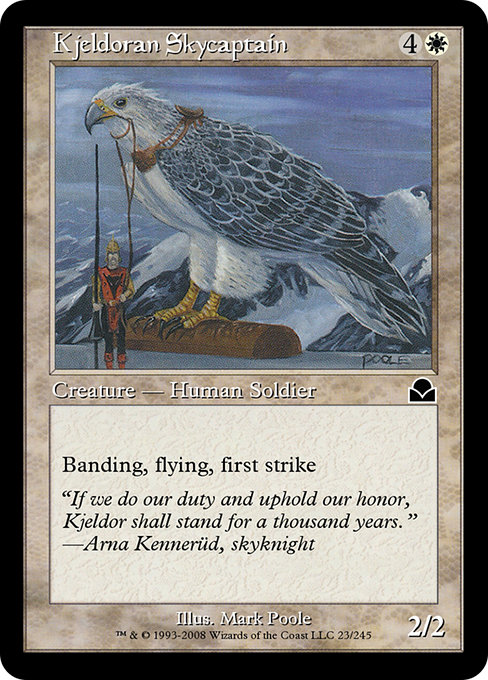
Image courtesy of Scryfall.com
Expression in White: Banding, Flight, and the Craft of Player Agency
Magic design is as much about what you let players decide as what you provide on the battlefield. Kjeldoran Skycaptain embodies a philosophy of player expression that feels both old-school and enduringly relevant. We’re talking about a white creature with a three-into-five mana curve that invites you to pilot your army not just by raw power, but by the art of arrangement. With flying, first strike, and banding bundled onto a single 2/2 body, this card hands you a toolkit for shaping battles in ways that depend entirely on your choices—who to band, who to fly over, and how to allocate combat damage. 🧙♂️🔥💎⚔️
Banding, that once-legendary rule, is a perfect case study in player expression. It doesn’t just say “you can attack in a band”; it says, “you decide the choreography.” If you control several banding creatures, you can combine them with others (or without) to craft formations that optimize both offense and defense. Skycaptain’s banding capability is a reminder that game design rewards social strategy and negotiation as much as individual stats. In a vacuum, a 2/2 flyer with first strike isn’t extraordinary. When you add banding, the card becomes a living puzzle—how do you position it with your other white soldiers to shape how damage is shared and which blockers you entice? The result is a mode of expression that’s both collaborative and tactical, inviting you to experiment with different tempos and lines of attack. 🧙♂️🎲
The flying keyword adds an air of inevitability—your aerial reach can pressure the ground, while first strike ensures you win tempo battles before the bigger frames collide. This triad is a microcosm of white’s broader design: protection, efficiency, and the moral optics of marching in lockstep with your squad. Skycaptain doesn’t just swing; it invites you to choreograph a sequence where every decision echoes your playing style. The flavor text—“If we do our duty and uphold our honor, Kjeldor shall stand for a thousand years.”—also hints at a worldview: unity and purpose, expressed through disciplined, purposeful combat. ✨
“If we do our duty and uphold our honor, Kjeldor shall stand for a thousand years.” —Arna Kennerüd, skyknight
Design Details That Encourage Personal Playstyles
From a design perspective, Skycaptain is a refreshing reminder that old mechanics can spark fresh expression in modern contexts. In formats where banding is allowed or where you’re reconstructing a nostalgic white-based swarm, this card becomes a flexible anchor. Its common rarity in Masters Edition II underscores how powerful ideas can be elegantly compact: a single card that teaches you to think more deeply about grouping, blocking, and timing. The set’s 2008 release date places Skycaptain in a period where Wizards was balancing forward momentum with retro appeal—an era that still resonates with players who crave a sense of “the way we used to play.” The artwork by Mark Poole, crisp and iconic, reinforces the archetype of a vigilant sky-sentinel guiding a disciplined, cavalry-like squadron. 🎨
In terms of gameplay, you can lean into banding as a social contract on the battlefield. When you control multiple banding creatures, the decision of how to split damage becomes a shared moment—one where your opponent reads your intent as part of the game itself. Skycaptain’s other keywords—flying and first strike—offer clear leverage in skirmishes, enabling you to threaten, deter, and trade efficiently. The net effect is a character-driven approach to combat: you’re not just playing a card; you’re directing a narrative of assault and defense, with every banded line signifying a strategic choice. This is the heart of player expression in design: a framework that rewards personal style without sacrificing clarity or balance. 🧙♂️
For collectors and lore enthusiasts, Skycaptain also carries a storyweight. It’s a reprint with historical significance (Masters Edition II reintroduces classic mechanics to a new audience), and its flight-capable silhouette sits nicely in a white-centric collection—think the noble archers, the vigilant knights, and the era-defining aura that white decks tend to cultivate. Even as the card sees modern play limited to a few historical formats, its philosophical impact on design philosophy—empowering player-driven formation and timing—remains a compelling case study for any designer or player aiming to translate theme into tangible tactics. 🧠💡
From Table to Tabletop: A Small, Personal Ritual
In a world of high-budget, hyper-fast Set design, Skycaptain reminds us that meaningful player expression often rides on elegant simplicity. A card that encourages you to think about bands, blocks, and the way damage is allocated can be as impactful as a flashy new mechanic. It’s a reminder that great design doesn’t always shout; sometimes it whispers, urging you to craft your own battlefield drama. If you’re a player who loves structuring your own tempo, or a collector who savors the story behind white’s strategic discipline, Skycaptain offers a quiet thrill—the moment you realize your opponent is adapting to your plan as you adapt to theirs. 🧭
As you set up your desk or game night, consider pairing a timeless card like this with a tactile, high-quality mouse pad that keeps pace with your strategy. Our featured product—a custom rectangular mouse pad—blends practical function with a nod to the tactile joy of tabletop play. It’s the kind of accessory that says you’re serious about the ritual of deployment, not just the thrill of victory. For fans who love the sensory feedback of a good game, it’s a small but meaningful upgrade that makes each match feel a touch more personal. 🧧🎮
custom-rectangular-mouse-pad-9-3x7-8-non-slip-backingMore from our network
- https://blog.rusty-articles.xyz/blog/post/sangrite-surge-why-its-artwork-became-mtg-iconic/
- https://blog.digital-vault.xyz/blog/post/dying-to-serve-mastering-the-mtg-stack-and-sequencing/
- https://crypto-acolytes.xyz/blog/post/the-scariest-sound-effects-in-gaming-youll-never-forget/
- https://transparent-paper.shop/blog/post/transparent-png-digital-papers-explained-a-quick-guide/
- https://blog.crypto-articles.xyz/blog/post/solana-meme-coin-faces-bearish-outlook-as-liquidity-holds/